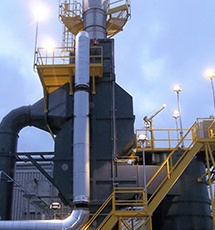In recent years, ammonia has increasingly become a regulatory concern. Due to the formation of fine particulate matter that has been linked to ammonia emissions into the atmosphere, the U.S. Environmental Protection Agency (EPA) has focused regulatory efforts on controlling these emissions, due to their statistical association with increased incidence of pulmonary disease and reduced lung function, cardiac arrest, and premature death. In addition, ammonia has an adverse effect on rivers, lakes, and aquifers, which has led to restrictions on ammonia emissions in wastewater.
While ammonia emissions are a concern, it is also a naturally occurring chemical that is essential for many biological processes. However, since many sources of biofuels contain ammonia or can create ammonia during processing, companies need to be aware of their ammonia emissions and how they can address them.
At Catalytic Products International, we regularly work with our clients to come up with innovative solutions for pollution control. We wanted to share the story of how we solved an ammonia discharge problem for a leading refinery:
The Problem
Our client's bio-refinery had a wastewater stream which contained significant amounts of ammonia, Volatile Organic Compounds (VOCs), and mercaptans. The chemicals in this stream were highly corrosive and had begun to damage the facility's boiler trains. This damage caused a number of unplanned outages, and required multiple costly repairs. In addition, the wastewater stream produced an offensive odor that needed to be eliminated. It was determined that a new method of destroying contaminants without damaging the facility or producing an offensive odor was required.
In addition to these requirements, the new system needed to minimize both capital and O/M costs while remaining simple to operate. As a further complication, the only energy source available was electricity, since gaseous fuels were not available at the facility.
The Solution
 Catalytic Products International approached this challenge as a chance to utilize our expertise in pollution control, and we designed a solution that utilized a counter-current stripping tower that would remove ammonia, VOCs, and mercaptans from the wastewater stream. The elements that had been removed formed a gas stream, which flowed into a custom-designed catalytic oxidizer that operated on electric power. By utilizing a particular catalyst that oxidizes both VOCs and ammonia, the oxidizer was able to convert VOCs to carbon dioxide and water, while also converting some – but not all – of the ammonia to nitrogen oxides (NOx).
Catalytic Products International approached this challenge as a chance to utilize our expertise in pollution control, and we designed a solution that utilized a counter-current stripping tower that would remove ammonia, VOCs, and mercaptans from the wastewater stream. The elements that had been removed formed a gas stream, which flowed into a custom-designed catalytic oxidizer that operated on electric power. By utilizing a particular catalyst that oxidizes both VOCs and ammonia, the oxidizer was able to convert VOCs to carbon dioxide and water, while also converting some – but not all – of the ammonia to nitrogen oxides (NOx).
Following this initial oxidation, a second catalyst was used to react with the residual ammonia and NOx, forming elemental nitrogen (N2) and water. This process minimizes emissions of both ammonia and NOx. By using a disposable "guard bed" that precedes the two catalysts, both catalyst beds are protected from the sulfides that can accompany mercaptans, minimizing damage to the catalysts.
With this new system, the facility's wastewater stream met local discharge requirements, the exhaust gas met all permit and regulatory limits, and objectionable odors were eliminated. The system met all performance criteria, ensuring optimal operation of the facility and eliminating the possiblity of unexpected outages due to damage from corrosive wastewater.
As ammonia discharges continue to attract the attention of regulators and policy-makers, these kinds of innovative solutions will become even more important.
Air Pollution Control Expertise
Catalytic Products International remains on the forefront of air pollution control, and our experts can help you understand the new technologies that will enable you to fulfill demand while meeting regulatory requirements. We'll work with you to find the best solutions for your most challenging emission control, engineering, and compliance needs.
Emission Control
At CPI, we specialize in creating custom-designed control systems for unique applications that involve issues such as high temperatures, large particulate loadings, variable loads, or highly toxic exhaust streams. We've been able to approach and overcome these challenges for multiple industries, including petrochemical, natural gas, electronics, and many others.
Our unique expertise and experiences have helped us assist the growing bio-fuel industry as innovators work to find new ways to produce fuels domestically.
With our experience and expertise, we can help you:
- Control VOC, NOx, and CO emissions, as well as other conventional “criteria” air pollutants.
- Reduce disposal costs by providing methods of cleaning wastewater.
- Control Hazardous Air Pollutant emissions.
- Help reduce emissions of greenhouse gases that are associated with production processes.
Engineering Expertise
Whether the best solution can be provided by a major system overhaul or a small tweak, CPI provides you with specialized engineering expertise that can help you take your business to the next level.
With decades of experience designing pollution control systems, we understand how to move gas streams most efficiently, how to use energy most economically, and how to squeeze every last dollar out of operational costs. We’ve partnered with a number of companies involved with bio-fuel technologies and helped them improve their processes and realize higher efficiencies and cost savings. We'll be your partner in innovation in areas like ethanol, gasification, and kinds of emerging bio-refining.
Compliance Assistance
Even if you're working with developing green technologies, you can still run afoul of exacting EPA requirements. With our extensive experience dealing with the EPA at both state and national levels, we can provide you with the tools you need to meet compliance economically.








